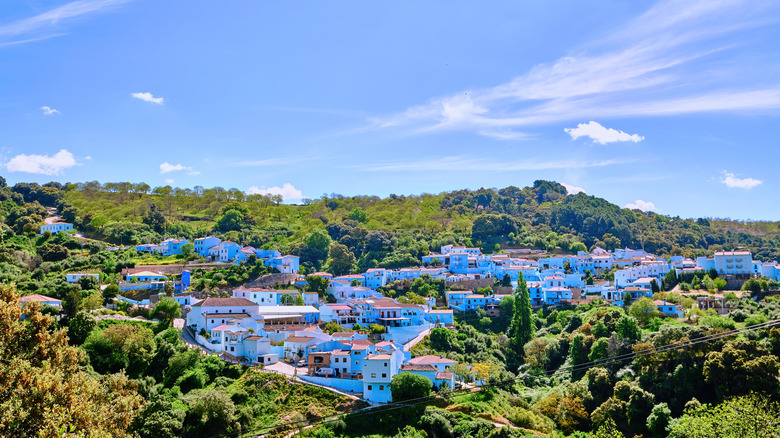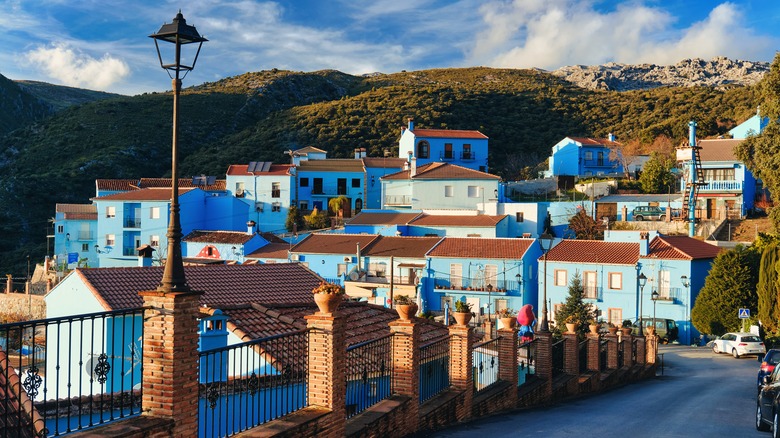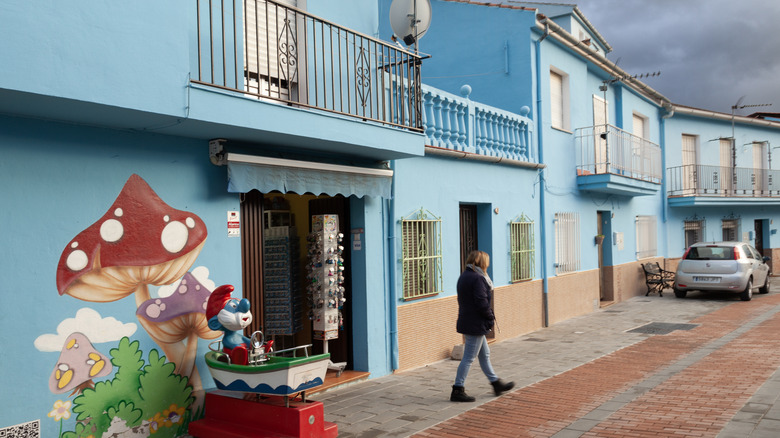One Of Europe's Quirkiest Destinations Has To Be This Bright Blue 'Smurf Village'
Nestled in the hillside of Andalusia, just two hours from Seville is a fairytale-like village that bears a rather unique heritage. This tiny mountaintop town wedged in the side of the cliffs once boasted a neutral, all-white color palette but was transformed into a bright blue canvas in 2011 during the release of "The Smurf Movie." In search of the perfect village to market the film, Sony Pictures selected Juzcar, Spain as their promotional destination to recreate the film's fictional Smurf village. The white-washed pueblo was quickly altered to reflect brightly pigmented baby-blue abodes with the help of 1,056 gallons of paint.
It may be small in size, but Juzcar makes for the perfect stop along an unforgettable Spanish road trip. Not far from neighboring coastal cities like Marbella, it's a surprisingly easy destination to reach. Despite the windy one-lane road, reaching Juzcar by car is the easiest way to enter this village. Juzcar's Mediterranean climate tends to remain moderate throughout the four seasons, making it an ideal year-round destination. However, the most fun European festivals in Juzar take place during the spring and fall, making these the most optimal seasons to visit. The town celebrates Holy Week every year in April, while fall is reserved for the Valle del Genal Mycological Days, an ode to the region's mushroom season that reaches a peak in November.
Smurfs take on Juzcar, Spain
The iconic village of Juzcar boasts one of the most fascinating stories in all of Spain, which isn't surprising given its fame as a real-life Smurf town. With nothing but acres of farmland surrounding the small Andalucian village, tourism is the driving force behind Juzcar's financial prosperity. The town's small population of just 400 residents had a 26% unemployment rate, so locals were thrilled at the prospect of receiving an influx of tourists that would hopefully boost the town's economy. To the locals' delight, their numbers soared from an annual average of 300 visitors to an astounding 80,000. Sony Pictures assured the town officials that the village would be restored to its original appearance following the launch of the film, but the increased cash flow was enough encouragement for locals to politely decline.
It wasn't just the postcard-perfect village and sleepy town vibe that drew Sony Picture's marketing department to Juzcar. They were searching for a town with personality and history that met the characteristics of the film. Known for its long-standing history rooted in mycology tradition (the study of fungi), Juzcar was a near-perfect fit for the Smurf's affection for mushrooms. Various species of fungi have flourished in this Spanish hilltop town for centuries, with over 150 species draped across the lush terrain. Combined with a vibrant culture, dreamy landscapes, and a thriving culinary scene, it wasn't a hard decision for the filming company to settle on Juzcar as their fairytale Smurf scene.
Get lost in Spain's favorite little blue village
Despite the initial excitement surrounding the launch of The Smurf Movie, Juzcar hasn't lost its charming small-town spirit that's still a beacon for tourists all over the world. To best explore the famous Smurf icon, take a walk along the famous Smurf mural route. With 14 brightly painted murals sprawled across the exteriors of local hotels, businesses, and residences, it makes for a quirky photo shoot to showcase on your Insta feed. Adventurous thrill-seekers will be enthralled by Juzcar's two ziplines that skim the rooftops of this azure-toned pueblo. Spanning 360 and 656 feet, there's no better way to take in the enchanting views of Juzcar's photogenic village.
If you want to dive deep into the mycology of Juzcar, stop by the Mushroom Museum (yes, it's really a thing!) to learn about the various species native to this Andalusian region. Infographics, glass displays, photographs, and interactive experiences cultivate a broader understanding of the abundant flora that blankets the landscape every autumn. For a more immersive experience, you can also try some of these natural delicacies for yourself at Bar y Tienda El Casarón, a seasonal tapas bar located in the heart of town. This small cantina doubles as a market space where you can purchase cheese, meats, wine, and other locally crafted fare.


